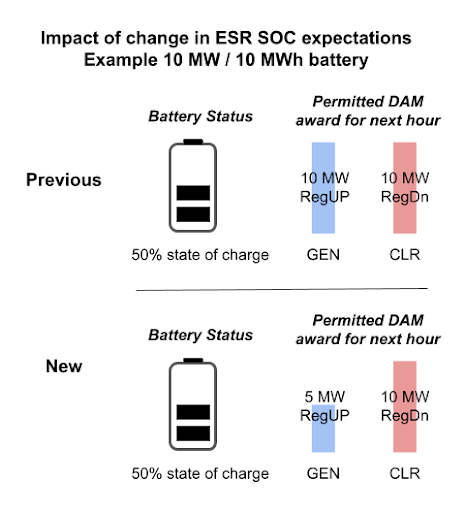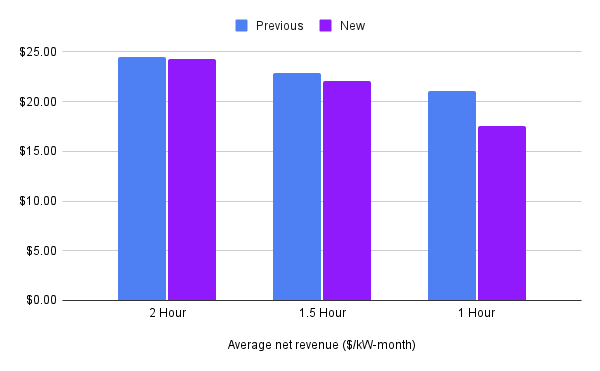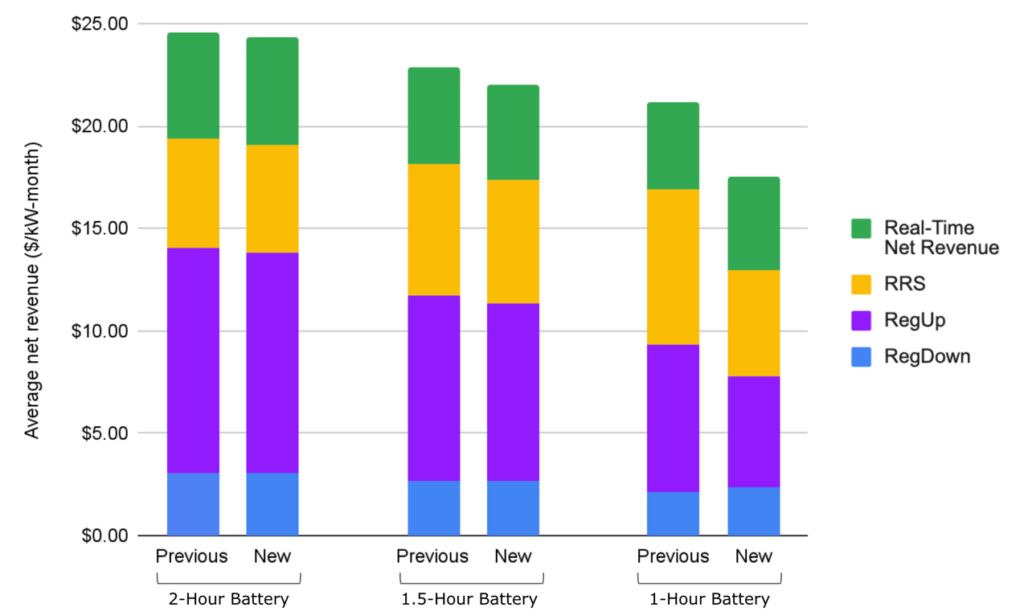Impact of new ERCOT state of charge guidelines on battery operations and net revenue
Author: Mia Nakajima, Gridmatic Data Scientist
In December 2022, ERCOT updated the Business Practice Manual (BPM) section: “ERCOT and QSE Operations Practices During the Operating Hour” to define state of charge (SOC) expectations for Energy Storage Resources (ESRs) providing ancillary services (AS), as well as AS transitions. These BPM updates reflect impactful changes compared to how ESR market participants had previously been operating based on their understanding of the Protocols.
One impactful new BPM SOC expectation applies at the beginning of any hour in which an ESR has a discharging ancillary service award (i.e., RegUp, RRS, Non-Spin). The new SOC expectation is that the ESR must be capable of satisfying all discharging AS awards held on the generation side for the full duration of the award. For example, if the ESR held 10 MW of RegUp or RRS on the generation side, it must have at least 10 MWh of SOC because RegUp and RRS have a 1-hour duration. Previously Market Participants had understood ESR SOC management to be the responsibility of the resource owner. For example, if the ESR held 10 MW of RegUp on the generation side, it would be acceptable to have less than 10 MWh of SOC so long as the ESR operator was able to satisfy the ancillary award. In this scenario, the ESR operator could manage its SOC to satisfy ancillary awards via multiple methods, including maintaining RegDown on the charge side, charging in the real-time energy market, or relying upon another resource within a QSE pool as a backstop. The new SOC expectations limit the operational flexibility of ESRs to deliver ancillary service awards. The impact is that ESRs will be able to satisfy a lower quantity of ancillary service awards over the course of the day, particularly for shorter duration ESRs for which the SOC requirements will become a frequent constraint in operations.

ERCOT Nodal Protocols vs Business Practice Manual
ERCOT Nodal Protocols outline the procedures and processes used by ERCOT and Market Participants for the orderly functioning of the ERCOT system and nodal market. Market Participants such as load serving entities, traders, and generating resources all follow the procedures and processes set out by the Protocols.
Changes to the Protocols require a Nodal Protocol Revision Request (NPRR), which is a process in which market stakeholders review, discuss, and determine implementation for any changes to the Protocols.
The ERCOT Business Practice Manual (BPM) provides supplemental information to explain or communicate the functionality of the ERCOT Systems and Processes. ERCOT updates the BPM when it determines updated guidance is needed by Market Participants.
The ERCOT market rules that guide enforcement actions are specified within the Protocols rather than in the BPM. The ESR SOC expectations introduce the possibility of ERCOT enforcement actions against ESRs that are not in compliance.
Using the same methodology as used in our Gridmatic Storage Report (as validated by DNV), we analyzed the impact of this change via a backtest of storage systems in ERCOT. We compared net revenue results for 2-hour, 1.5-hour and 1-hour batteries.
Summary
Under the new requirements, change in battery net revenue is correlated to duration, with shorter duration batteries likely to exhibit lower net revenue per MW than longer duration systems. In our backtests, the 1.5-hour and 2-hour batteries have a decrease in average net revenue of less than $1/kW-month but the 1-hour battery has a decrease of $3.60/kW-month.
The majority of the lower expected net revenue for shorter-duration batteries comes from lower RRS and RegUp participation.
Findings
Gridmatic backtested 2-hour, 1.5-hour and 1-hour batteries, comparing average USD/kW-month net revenue, using a 12 month lookback period of February 2022 through January 2023. The trading algorithm used in this analysis is a “perfect foresight” analysis, meaning that all market prices are known to the Gridmatic battery optimizer ahead of time. For this reason, the absolute dollar value of revenues is higher than we expect an actual ESR resource to achieve, but we expect the correlation between change in battery net revenue and ESR duration to be similar in real-world results.
In tests comparing batteries of various durations under the new protocols compared to the previous protocols, 2-hour batteries had a slight decrease in net revenue of 0.8%. 1.5-hour batteries exhibited about a 3.5% decrease, and 1-hour batteries have a significant decrease in net revenue of almost 17.1%.

Average net revenue under new ESR SOC expectations compared to previous:

The decrease stems from the shorter-duration batteries’ reduced participation in revenue opportunities due to their awards being limited by their SOC. For example, a 1-hour battery and 1.5-hour battery could only be awarded nameplate capacity for RegUp or RRS while having 100% SOC and 66% SOC respectively. Some net revenue sources such as RegDown and Real-Time net revenue (Real-time energy + ORDC) are preserved or even increase slightly, but RegUp and RRS revenues both decrease.

Note: We combined ORDC with Real-Time Energy into the Real-Time Net Revenue category.
Comparison to CAISO
Battery rules in CAISO differ from ERCOT in numerous ways. Regarding battery SOC during the provision of ancillary services, CAISO requires a battery to maintain 50% of the energy required to deliver a nameplate ancillary award in the upcoming hour (vs 100% in the case of the new ERCOT BPM SOC expectations). The CAISO SOC rules enable batteries of various durations to have greater participation in ancillary services.
For example, in CAISO, battery operators will often pair RegUp with RegDown operations. There is increased net revenue opportunities because the averaging of charging and discharging enables the battery to maintain a neutral SOC. Under the new ERCOT ESR SOC expectations, it will be more difficult for short duration batteries in ERCOT to operate in this fashion, thereby limiting the ability of battery resources to provide a higher output of ancillary services.